NEWSTEAD ABBEY
Lord Byron's Ancestral Home - A Love Affair
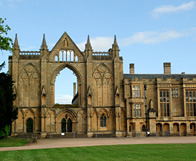 Not really a castle, but a manor house with a delicious history. Newstead Abbey in Nottinghamshire is best known as the one time home of the romantic era poet Lord Byron. The property was originally an Augustinian Priory of St Mary founded by King Henry II around 1170 as penance for the murder of Thomas a Beckett, set in the heart of the royal hunting forest of Sherwood, remaining until the monastery was dissolved in 1539 by Henry VIII, who dissolved and destroyed hundreds of monastic enclaves across England, leaving only the haunting icons of abbey ruins for posterity
(see Whitby
Abbey Yorkshire) and offering the former church lands for sale at
bargain prices. The lands of Newstead Abbey were bought by Sir John Byron,
then
the Lord Lieutenant of Nottingham for the total of £810 in 1540.
Not really a castle, but a manor house with a delicious history. Newstead Abbey in Nottinghamshire is best known as the one time home of the romantic era poet Lord Byron. The property was originally an Augustinian Priory of St Mary founded by King Henry II around 1170 as penance for the murder of Thomas a Beckett, set in the heart of the royal hunting forest of Sherwood, remaining until the monastery was dissolved in 1539 by Henry VIII, who dissolved and destroyed hundreds of monastic enclaves across England, leaving only the haunting icons of abbey ruins for posterity
(see Whitby
Abbey Yorkshire) and offering the former church lands for sale at
bargain prices. The lands of Newstead Abbey were bought by Sir John Byron,
then
the Lord Lieutenant of Nottingham for the total of £810 in 1540.
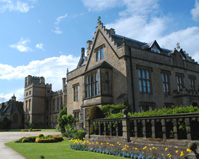 Lord George Gordon Byron, the 6th Baron of Rochdale, where the property from which the Byrons' titled derived, loved Newstead Abbey, as if loving from afar makes the heart fonder. "Newstead and I stand or fall together", he wrote in a letter to a friend, but actually spent relatively little time there, away at college and in London, then traveling. Newstead Abbey was occupied by Byron’s second wife, Annabella, when he was away, but in a clear sign of the unpleasantness of his marriage, he would arrange for his wife to stay in another house when he was at home, which added to his debts from the rising costs of maintenance on the property and his own profligate spending. Byron swore he would never sell Newstead Abbey, but following his mother’s death and the pressing scandals of his serial affairs, he left England for the continent in 1816, never to return. Newstead Abbey was sold to Thomas Wildman in 1818. Wildman spent a fortune gained from plantations in the Caribbean to restore Newstead which had fallen into considerable disrepair under the Byrons. The most famous view of Newstead Abbey is the remaining west front of the gothic priory dating from the 13th Century. The residential mansion retains some medieval character but is mostly 19th Century gothic revival, with the Sussex Tower to the main house added by Wildman.
Lord George Gordon Byron, the 6th Baron of Rochdale, where the property from which the Byrons' titled derived, loved Newstead Abbey, as if loving from afar makes the heart fonder. "Newstead and I stand or fall together", he wrote in a letter to a friend, but actually spent relatively little time there, away at college and in London, then traveling. Newstead Abbey was occupied by Byron’s second wife, Annabella, when he was away, but in a clear sign of the unpleasantness of his marriage, he would arrange for his wife to stay in another house when he was at home, which added to his debts from the rising costs of maintenance on the property and his own profligate spending. Byron swore he would never sell Newstead Abbey, but following his mother’s death and the pressing scandals of his serial affairs, he left England for the continent in 1816, never to return. Newstead Abbey was sold to Thomas Wildman in 1818. Wildman spent a fortune gained from plantations in the Caribbean to restore Newstead which had fallen into considerable disrepair under the Byrons. The most famous view of Newstead Abbey is the remaining west front of the gothic priory dating from the 13th Century. The residential mansion retains some medieval character but is mostly 19th Century gothic revival, with the Sussex Tower to the main house added by Wildman.
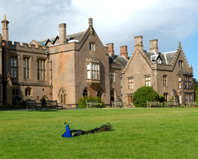 A few items of Byron’s legacy remain at Newstead Abbey. In the Byron Rooms upstairs, the poet’s great ornate bed, which he dismantled and took with him on his travels, seeming nearly impossible to remove from the chamber can be found along with the round table on which he wrote some of his early works and a collection of the Byron family crests. What is missing? As late as the 1970’s one could see a distinctive feature at Newstead, now gone to memory. The approaching drive to the house was once lined with great thick oak tree stumps, shorn to nearly ground level. The trees were cut down and sold off by one Lord Grey de Ruthyn, Henry Yelverton, who was leasing the property. Byron returned from Harrow as a teenager to stay at Newstead when Lord Ruthyn was its occupant, leading to its perhaps curious tie to the invention of the appearance of the vampire in English gothic literature. During the famous Gothic Summer of 1816 in Geneva (see Villa
Diodati and Byron), a bet was made that
great literary figures like Byron and Percy Shelley should be able to
write gothic horror stories, famously recounted by Mary Shelley in an
introduction of her novel “Frankenstein” (see Mary
Shelley's London). For Byron’s contribution, he began a story which transformed into the first vampire tale published in English, derived from legends Byron had heard while traveling in Greece. Byron abandoned the tale, having become bored with it and its too personal connection. The fragment of the story was then taken up by his doctor and traveling companion, John Polidori who finished it and published “The Vampyre” under his own name. The lead character of the vampire in Polidori’s version was named Lord Ruthven, long believed to be modeled on Byron, though seeming more a pseudonymous dig at Lord Ruthyn, with whom Byron had a notorious angry break. It has been postulated by some that Byron had been molested (or a daliance, depending on your point of view) by Yelverton
as a young man, but another source of resentment which might have turned
Lord Ruthyn into a vampire character is that Ruthyn had all the magnificent
ancient oak trees lining the drive cut down and sold for profit while
he was only renting the place.
A few items of Byron’s legacy remain at Newstead Abbey. In the Byron Rooms upstairs, the poet’s great ornate bed, which he dismantled and took with him on his travels, seeming nearly impossible to remove from the chamber can be found along with the round table on which he wrote some of his early works and a collection of the Byron family crests. What is missing? As late as the 1970’s one could see a distinctive feature at Newstead, now gone to memory. The approaching drive to the house was once lined with great thick oak tree stumps, shorn to nearly ground level. The trees were cut down and sold off by one Lord Grey de Ruthyn, Henry Yelverton, who was leasing the property. Byron returned from Harrow as a teenager to stay at Newstead when Lord Ruthyn was its occupant, leading to its perhaps curious tie to the invention of the appearance of the vampire in English gothic literature. During the famous Gothic Summer of 1816 in Geneva (see Villa
Diodati and Byron), a bet was made that
great literary figures like Byron and Percy Shelley should be able to
write gothic horror stories, famously recounted by Mary Shelley in an
introduction of her novel “Frankenstein” (see Mary
Shelley's London). For Byron’s contribution, he began a story which transformed into the first vampire tale published in English, derived from legends Byron had heard while traveling in Greece. Byron abandoned the tale, having become bored with it and its too personal connection. The fragment of the story was then taken up by his doctor and traveling companion, John Polidori who finished it and published “The Vampyre” under his own name. The lead character of the vampire in Polidori’s version was named Lord Ruthven, long believed to be modeled on Byron, though seeming more a pseudonymous dig at Lord Ruthyn, with whom Byron had a notorious angry break. It has been postulated by some that Byron had been molested (or a daliance, depending on your point of view) by Yelverton
as a young man, but another source of resentment which might have turned
Lord Ruthyn into a vampire character is that Ruthyn had all the magnificent
ancient oak trees lining the drive cut down and sold for profit while
he was only renting the place.
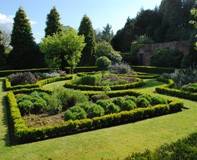 Though the stumps are gone, the beautiful gardens and parkland at Newstead Abbey cover more than 300 acres, with its lakes, ponds and waterfall cascades provided by the waters of the Leen River. The Eagle Pond takes its name from the former priory's eagle-shaped lectern, which was legendarily thrown into the lake by the monks to hide it from the looters of the Abbey and now to be found at Southwell Minster. The Eagle Pond lies at the heart of the walled Great Garden to the east of the house, where can be found Byron's famous monument to his favorite dog, a Newfoundland Hound named Boatswain, who died of rabies in 1808. The monument, inscribed on marble stained with time, Byron’s “Epitaph to a Dog” is located where Byron believed the altar of the priory church once stood. Byron wanted to be buried with Boatswain, perhaps his only true lasting love, but his wish was ignored by his family after his death from "a chill" while away in Greece, and he was instead interred in the nearby church at Hucknall.
Though the stumps are gone, the beautiful gardens and parkland at Newstead Abbey cover more than 300 acres, with its lakes, ponds and waterfall cascades provided by the waters of the Leen River. The Eagle Pond takes its name from the former priory's eagle-shaped lectern, which was legendarily thrown into the lake by the monks to hide it from the looters of the Abbey and now to be found at Southwell Minster. The Eagle Pond lies at the heart of the walled Great Garden to the east of the house, where can be found Byron's famous monument to his favorite dog, a Newfoundland Hound named Boatswain, who died of rabies in 1808. The monument, inscribed on marble stained with time, Byron’s “Epitaph to a Dog” is located where Byron believed the altar of the priory church once stood. Byron wanted to be buried with Boatswain, perhaps his only true lasting love, but his wish was ignored by his family after his death from "a chill" while away in Greece, and he was instead interred in the nearby church at Hucknall.
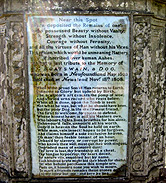 A few ghosts are said to roam Newstead Abbey, the son of the first Lord Byron, called "Little John with the Great Beard", a former Prior, is said to inhabit the more notorious Haunted Room among the Byron apartments. A dark robed monk known as the Black Friar wanders the grounds and the scent of the Rose Lady seems to linger around the staircase. Events and activities are held at Newstead Abbey during the year. Some past events have been a Jane Austen Ball and Victorian weekends and ghost tours are given with the appearance of a rather counterfeit ghost lady in white.
A few ghosts are said to roam Newstead Abbey, the son of the first Lord Byron, called "Little John with the Great Beard", a former Prior, is said to inhabit the more notorious Haunted Room among the Byron apartments. A dark robed monk known as the Black Friar wanders the grounds and the scent of the Rose Lady seems to linger around the staircase. Events and activities are held at Newstead Abbey during the year. Some past events have been a Jane Austen Ball and Victorian weekends and ghost tours are given with the appearance of a rather counterfeit ghost lady in white.
Visiting Newstead Abbey
The grounds of Newstead Abbey are open every day through the year from 9am to 6pm. The house is only open Fridays to Mondays from April through September 12 noon to 5 pm. Admission for the grounds and the house is £7 for adults, £3.50 for the grounds only. Newstead Abbey is located 9 miles north of the city of Nottingham. © Bargain Travel Europe
Compare best hotel and travel deals in Nottingham on TripAdvisor
Web Info
Newstead Abbey
These articles are copyrighted and the sole property of Bargain Travel Europe and WLPV, LLC. and may not be copied or reprinted without permission.
See Also:
BURGHLEY HOUSE - GREAT ELIZABETHAN MANOR
CRICH
TRAMWAY VILLAGE MATLOCK
MORTIMER'S
HOLE - NOTTINGHAM CASTLE
REAL ROBIN HOOD'S OAK OF SHERWOOD FOREST




